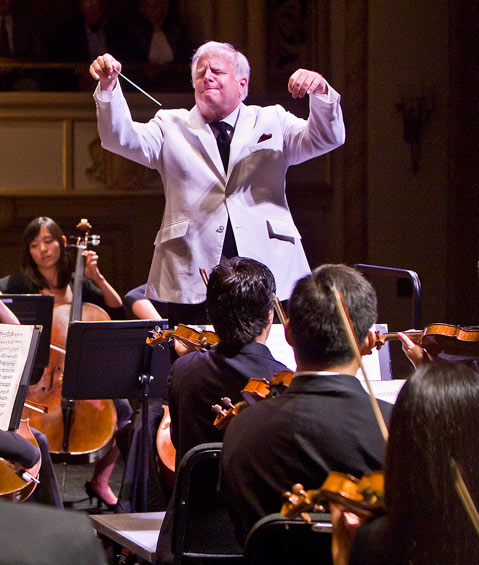Review: Academy Festival Orchestra at the Granada Theatre
Music Academy Orchestra Plays Beethoven, Shostakovich on July 13
A revved-up Academy Festival Orchestra took to the Granada stage on Saturday with a clear sense of mission: to Russia, with love, via the indispensable Symphony No. 5 in D Minor, Op. 47 of Dmitri Shostakovich. Intermediate stops in this world-traveling program included the cosmopolitan San Juan, Puerto Rico, of Roberto Sierra’s Fandangos (2000) and the compositional heights of Beethoven’s Symphony No. 8 in F Major, Op. 93. The Sierra made a great showcase for the orchestra’s brass and reeds and offered an intriguing glimpse of this impressive composer’s musical personality.

Beethoven’s musical personality is of course well known, but that doesn’t make his enigmatic, highly sophisticated Eighth Symphony any less of a puzzle, or a pleasure. Amid the familiar dynamics of sonata form in the allegro vivace e con brio first movement, the first hints of this work’s innovations begin to appear in the form of a crescendo that’s not in the expected place. From there, the No. 8 takes off, with Beethoven at his most creative, especially rhythmically. Maestro Leonard Slatkin found the right balance of energy and restraint, giving the tick-tock tricks of the second movement necessary emphasis without ever losing the thread of the work’s larger structures or sacrificing the sensuous tone of the ensemble. By the long and wild allegro vivace fourth movement that concludes the symphony, it was clear that this Festival Orchestra is ready for anything, and that we are blessed this summer with what has to be one of the most impressive student orchestras in the world.
It’s rare that a Beethoven composition gets upstaged at a symphony orchestra concert, and while that’s not exactly what happened here, it’s true that the Shostakovich Symphony No. 5, which came after the intermission, was unquestionably the main attraction of the night. It’s a monumental work, written under tremendous pressure at a time when the slightest wrong move could have cost the composer his life. With Stalin virtually looking over his shoulder, Shostakovich dug deep and came up with one of the most compelling musical compositions in history. The work explores a seemingly endless succession of ensemble combinations and textures, ranging from the delicacy of flute and harp to the dark urgency of massed cellos and trombones. While there’s ample evidence to support the idea that this music portrays the Russian people in a time of great sorrow, there’s also a defiant and even a hopeful aspect to the work’s grandeur and dynamism. It was exciting to watch the hand and baton of conductor Leonard Slatkin as he expertly called out every nuance of this complex, ever-shifting masterpiece.
Prokofiev may be the Russian composer who set Leo Tolstoy’s War and Peace to music, but it was Shostakovich who put the Russian symphony on aesthetic par with that great work. Just as Tolstoy exploded the form of the traditional novel into something bigger and more encyclopedic, so Shostakovich took the symphony form as a point of departure for his own adventures into previously unknown musical territory. It’s remarkable how, in just a few short weeks, this orchestra has come together as a group capable of exploring these great monuments of the repertoire, and it’s exciting to imagine what they will do with the Mahler and Berlioz compositions scheduled for their final concert at the Granada on August 10.



